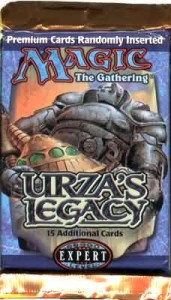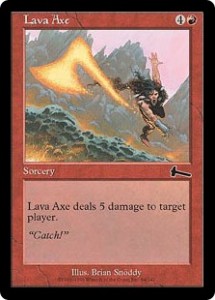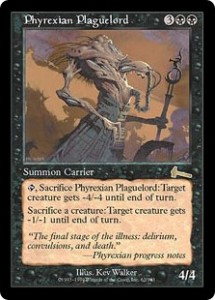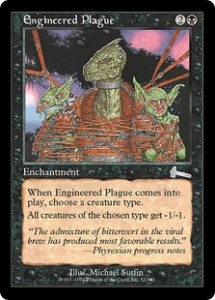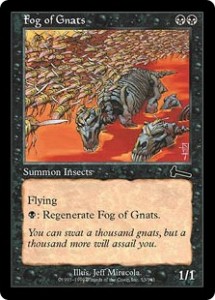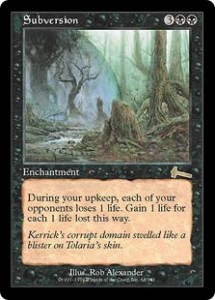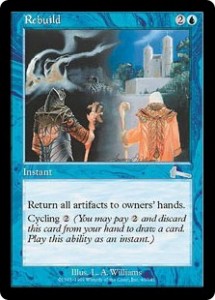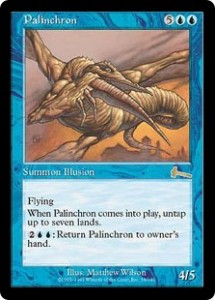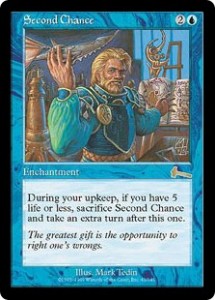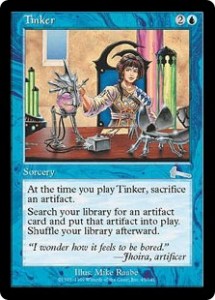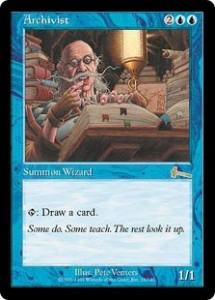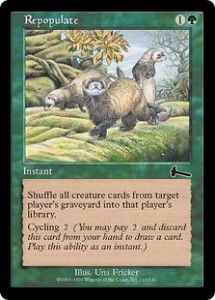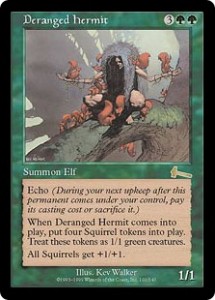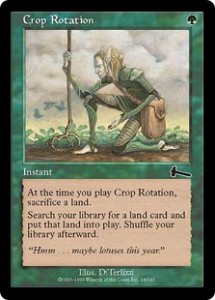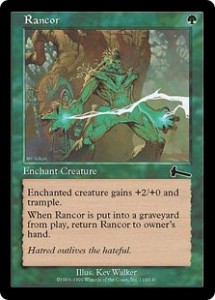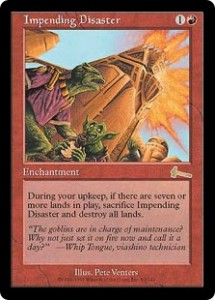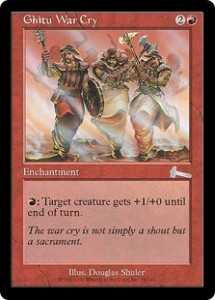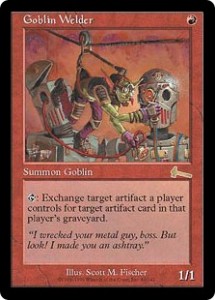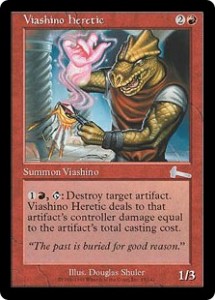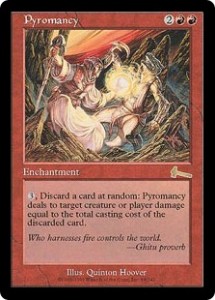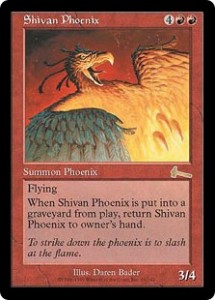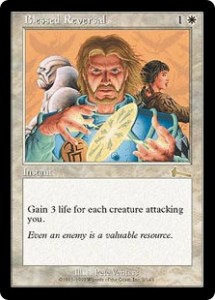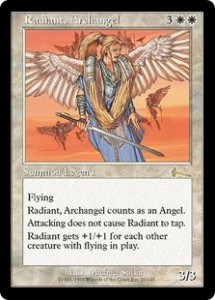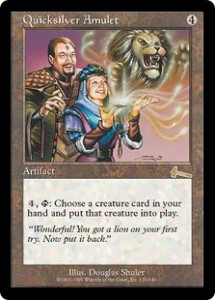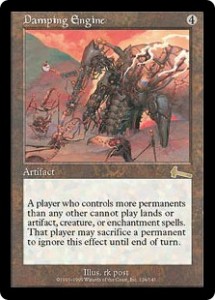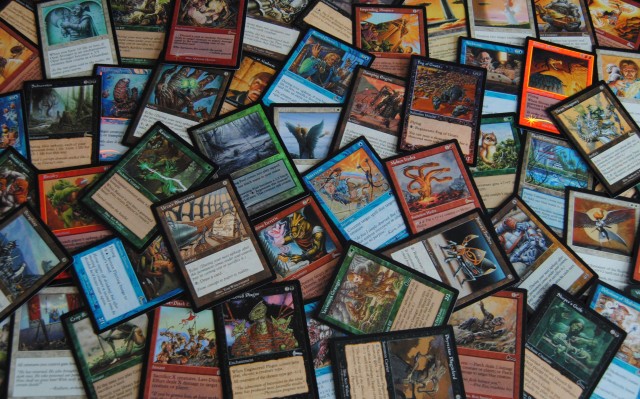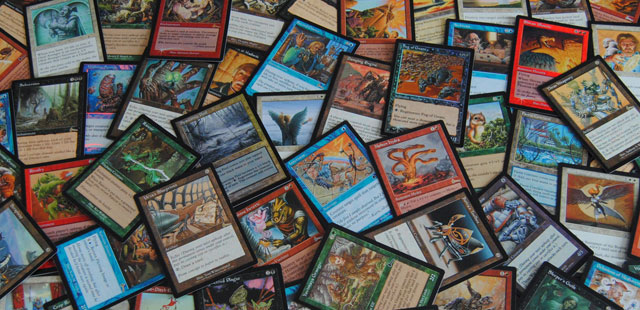
An Introduction to Urza’s Legacy
Released February 1999 as the first expansion to Urza’s Saga in the Urza’s Block, Urza’s Legacy with it predecessor created the “combo winter.”
This was of course a turning point for Magic: The Gathering, because DCI’s “emergency banning” of Memory Jar, just days after it became tournament legal, had players leaving the game en masse. But it wasn’t all doom and gloom.
Urza’s Legacy followed the same formula of Stronghold and Exodus as a 143 card set, with 55 commons, 44, uncommons and 44 rares. The color breakdown was almost the same as those sets, as well, with 24 Black cards, 24 Blue cards, 24 Green cards, 24 Red cards, 24 White cards, 18 Artifacts and five Lands. Urza’s Legacy also included Foil versions of the cards in the set as well, for the collectors.
Taking cues from it’s parent set Urza’s Saga, Legacy contained a set of perpetual enchantments and continued the “sleeping enchantment” concept, which was used for the Veiled, hidden and Opal enchantments in Saga.
The five Lands in the set where each considered “manlands” because they could each be tapped either for one Mana of their respective color or could be turned into a creature until end of turn.
The “echo” ability was expanded from being a completely creature ability to being applied to Artifacts, as well, and cycling continued to take hold.
Of the 143 cards in the set, only three were reprints; Blessed Reversal the lone reprint from Portal, while both Lava Axe and Lone Wolf were originally printed in Portal Second Age.
The controversy of Memory Jar’s “emergency banning” notwithstanding, Urza’s Legacy has a legacy all it’s own, thanks to some cards that stand at the forefront of memories when remembering the set, such as, Archivist, Crop Rotation, Goblin Welder, Rancor and Tinker, among others.
The Land of Urza’s Legacy: Oh, the Manlands
The “manlands” aren’t anything new. Turning lands into creatures has been the ability of artifacts, creatures and enchantments for as long as there has been Magic. However, the godfather of the “manlands” was Antiquities’ Mishra’s Factory.
The Lands of Urza’s Legacy took the Mishra’s Factory, to a whole new level, allowing you to not only tap the Land for a color of Mana, but turning the land into more than just a 2/2 Artifact creature. All of the “manlands” did come into play tapped, but most were worth it.
Faerie Conclave, could be turned into a 2/1 flying Blue creature until end of turn, Forbidding Watchtower a 1/5 White creature, Ghitu Encampment a 2/1 Red creature with first strike, Spawning Pool a Drudge Skeleton and Treetop Village a War Mammoth. Although it cost one colorless and one colored Mana to turn them into creatures, these Lands were still widely utilized when they first came out and were great selections when drafting for sealed deck tournaments.
The Color Black in Urza’s Legacy: More of the Same old, same old plus some Anti-Tribal
Cycling and echo were making inroads into the mainstream, but for Black the mainstream was still discard, reanimation and destruction.
Unearth was a cycling Raise Dead for creatures with total casting cost three or less, but it put that target creature into play, instead of just into your hand. This was great in combination with any number of inexpensive casting cost, yet large creatures. Swat was a cycling mini-Reprisal, destroying target creature with power two or less, while the original White Reprisal from Alliances, was power four or greater. Although Unearth saw more play, neither was put into heavy rotation.
Black’s perpetual enchantment was Sleeper’s Guile a Fear that just never died. One of the more intriguing creature enchants in Black was Treacherous Link, which redirects to is controller all damage dealt to enchanted creature. This may not seem like a big deal, in fact most would say the perpetual Fear is more useful, but put Treacherous Link on a Glacial Wall or Wall of Stone, something that can take damage without dying and you really have something.
The Phyrexian Clan made a statement in Legacy’s Black. Phyrexian Denouncer was a 1/1 carrier that could be sacrificed to give target creature -1/-1 until end of turn. The Phyrexian Debaser was a flying 2/2 carrier that could be sacrificed to give target creature -2/-2 until end of turn, the Phyrexian Defiler a 3/3, that could be sacrificed to give target creature -3/-3 until end of turn and all of this was somewhat useful, but not as fear inducing as Phyrexian Plaguelord, the one carrier to rule them all.
Phyrexian Plaguelord, in line with the rest was a 4/4, that could be sacrificed to give target creature -4/-4, but had an additional ability that allowed you to “sacrifice a creature: target creature gets -1/-1 until end of turn.” With Fallen Empires‘ Breeding Pit in play, it’s like a never-ending supply of temporary -1/-1 counters. Of course, what’s better than temporary -1/-1? Permanent -1/-1, of course.
Engineered Plague was that answer and it was also the ultimate in anti-tribal. “When Engineered Plague comes into play, choose a creature type. All creatures of the chosen type get -1/-1.”
Engineered Plague had a few benefits and it was all about timing. First, bouncing enchantments back to your hand for recasting was easier than ever. In addition to the fact that tribal decks were very in fashion. Lastly, this uncommon only cost two colorless and one Black Mana. Second to Tempest‘s Extinction this was as good as massive anti-tribal was going to be, during it’s time in Type II.
More specifically, for Green tribal decks, Rank and File was a 3/3 summon zombie, that when it came into play gave all Green creatures -1/-1 until end of turn.
For those decks that aren’t tribal, yet remain creature based, you could employ No Mercy, which simply states, “whenever a creature successfully deals damage to you, destroy it.” Sure those creatures are going to hit you, but it will be the last time they ever do.
The Phyrexians weren’t done with Legacy until they had Phyrexian Reclamation, which was a boon for reanimators. For one colorless and one Black Mana, you pay two life and return target creature from your graveyard to your hand.
Lurking Skirge, was a Black enchantment in the vein of Urza’s Saga‘s Veils, hiddns and Opals, turning into a 3/2 flying imp when a creature is put into an opposing graveyard.
Brink of Madness, one of the five sleeping enchantments (one for each color), was great for discard decks, because during your upkeep, if you have no cards in your hand, it was sacrificed to force target opponent to discard their hand.
Another favorite from the set for discard was Ostracize, which allowed you to look at target player’s hand to choose a creature card there, which that player then had to discard. The only downfall being that if they had no creatures in their hand it was a wasted play.
Bone Shredder was one of the new echo cards that had an ability built in. For two colorless and one Black Mana, you got a 1/1 flyer that when it comes into play has a Terror attached to it. Whether you paid the echo cost or not to keep the creature, the Terror effect was useful, and it didn’t cost much more than a Terror to begin with.
The best small Black creature in recent memory for the Urza’s Block was Fog of Gnats, either an expensive Will-‘o-the-Wisp or a flying Drudge Skeletons, this two Black Mana costing flying 1/1 with regeneration was useful in every Black deck imaginable.
Subversion was a great play for melee decks, although it wouldn’t gain you any friends or allies. During your upkeep, each opponent loses one life and you gain one life for each life lost this way. In a five player melee, that’s four life you’re gaining per turn, making you a fast target. However, with a Fog of Gnats or a Will-‘o-the-Wisp, or some creature control with Icy Manipulator/Royal Assassin, you may be able to hold off the onslaught of four players beating down on you… Either way, good luck.
The Color Blue in Urza’s Legacy: Good cards, Power cards, “Free” cards and Card Draw
As usual, Blue had counters and boomerangs and control and card draw but the big new thing from Blue’s Urza’s Legacy was the “free” cards.
Free cards, once cast untapped a number of Lands up to the converted Mana cost of the spell. So they weren’t free, but they were virtually free. Frantic Search was an instant for two colorless and one Blue Mana that allowed you to draw two and then discard two cards and it also untapped up to three Lands.
Snap was a free Boomerang, that cost one colorless and one Blue Mana and untapped up to two Lands. Snap, of course, was extremely useful early on to return a creature to your opponent’s hand without tapping out, so you could in theory counter that creature next turn if you needed two.
Because of the untapping and because it was one colorless and one Blue, instead of two Blue Mana it did replace Boomerang in a few decks. Even though it didn’t have the versatility of “return target permanent” and was limited to creatures, tribal decks and creature heavy decks were well in full force at the time, so it wasn’t a gamble as to whether or not it would be useful. It would be.
As great as Snap was, the best free card, at that time (as more would be coming in future sets), was Cloud of Faeries; one colorless and one Blue Mana, for a 1/1 flyer, that untapped up to two Lands when it came into play. It was great, not just because early on it was wonderful to cast and still maintain Mana for a counter, but also because it had cycling, so at turn 12, when it’s not as useful, you could cycle it away.
More cycling for Blue came in the form of Rebuild, which was a cycling hurkyl’s Recall and Miscalculation was a cycling Power Sink for two or a cycling double Force Spike, depending on which card you associate with more.
Another counter, of sorts was Intervene, which countered a spell that targets a creature. Now, it won’t save you from Wrath of Gods and Armageddons, but it will stave off that Pacifism and it only costs one colorless Mana.
Let’s talk about a potentially huge creature that was Anthroplasm. It cost two colorless and two Blue mana and was a 0/0 that came into play with two +1/+1 counters on it. At any time you could pay X and tap it to remove all +1/+1 counters from it and put X counters back on it. This doesn’t seem like a big deal, but with Urza’s Saga‘s Tolarian Academy, Apprentice Wizard and the ability to possibly untap and retap the Academy as well, Anthroplasm had big potential. Of course, it could also be Lightning Bolted, before you had the opportunity to make it bigger.
If you wanted to control your creatures, by moving them from play back to your hand, then Fleeting Image and Palinchron were great for you. Fleeting Image, a 2/1 flyer that cost one colorless and one Blue to cast, could be returned to your hand, by essentially paying it s casting cost, because that how much the activated ability cost. Palinchron on the other hand was one of the “free” cards, but wasn’t easy to reuse.
Palinchron, was a flying 4/5 for five colorless and two Blue Mana, that untapped up to seven Lands when it came into play. It could also be returned to owner’s hand for two colorless and two Blue Mana. In spite of the fact that it wouldn’t tap you out to cast it, Palinchron didn’t see the kind of play that Fleeting Image, as a bounceback, or Cloud of Faeries as a “free” card saw.
With all of the enchantment fun being had by the developers of the Urza’s block thus far, someone in the room must have stood up for control and that is why we have Aura Flux, the anti-enchantment enchantment, which gives all other enchantments an upkeep of “pay two colorless Mana or sacrifice this enchantment.”
Blue did have its fair share of ridiculous enchantments as well, the top of the list being Delusions of Mediocrity. When Delusions comes into play you gain 10 life and when it leaves play you lose 10 life. Even though a Disenchant or Tranquility or any number of other creatures would render this life gain temporary at best, it was a decent last ditch effort to stay alive.
Speaking of last ditch efforts, Second Chance, was the sleeping enchantment for Blue. It was a Time Walk for you to use if and when you have five or less life. Was Second Chance a Time Walk? No, but did players employ it into their decks, with limited use yes. I mean, a redone Time Walk would have had playsets in every Blue deck, but because of the limited use for Second Chance, it was usually limited to being put into decks in either ones or twos, rarely threes and almost never as a playset of four.
Blue didn’t give up it’s hold on library manipulation either. Raven Familiar, had echo and when it came into play allowed you to choose one card from the top three of your library and put it into your hand and the rest on the bottom of your library. Next turn, you could decide whether to pay the echo and keep the 1/2 flying bird, but it was the ability most liked to use the Raven for.
The amount of Tims in Blue was growing and Urza’s Legacy added to their ranks with Thornwind Faeries, as not just a Tim but a flying Tim. It’s probably also important to note that as Rootwater hunter was the Merfolk Tim, Thornwind Faeries was the, Faerie Tim. But most importantly, Tim deck’s just received a flyer and that was horrible news for Goblin and Elf deck’s everywhere.
Artifact combos and any deck that relied a particular artifact in general was extremely pleased to see Tinker. This sorcery was essentially an artifact tutor, that had the additional cost of sacrificing an artifact, when it was cast, but it also put the selected artifact into play and not into your hand, so it was huge for some decks, because if you didn’t counter the Tinker, you couldn’t counter the artifact. Anyway, just think about the artifacts you would love to just get into play, then play Tinker and go to town.
Is that one creature ability completely destroying you? Is it possible, that one flying or trample or first strike creature is completely undoing you or your army? Yes, and if this is the case, Urza’s Legacy’s Blue has Walking Sponge to help you out.
This one colorless and one Blue Mana costing 1/1 can be tapped to removed flying, first strike or trample from target creature until end of turn. I used to use this to remove trample so I wouldn’t take any damage when something small and regenerative blocked something big and tramply. But with all this goodness, Blue still had some great card draw
For instant card draw, Opportunity was a four card Braingeyser for the same cost of six mana. It wasn’t just draw four cards, it was “target player draws four cards,” so you could be creative with its uses, but it was second fiddle to the big card draw advantage creature of Archivist.
For two colorless and two Blue Mana, you received a 1/1 wizard that could be tapped to draw a card. Although the Archivist was just a 1/1, it could be protected and was useful, for “at the end of your turn” draws. It may not be the best creature, but for card draw, with no activated cost, this was simply great.
The Color Green in Urza’s Legacy: Multani’s Emergence, Squirrels, and helpful Spells
Green started to really come into its own in Legacy, but there were some set standards that Green had to have; Echo and cycling cards, creature buffs and some crazy fun cards.
Repopulate was the brilliance of cycling. It could shuffle all creature cards from target player’s graveyard into that player’s library. It’s a cycling Feldon’s Cane for your creatures or you could draw a card if that was more opportune. By Legacy people were really getting the hang of what to use cycling for.
Echo on the other hand was hit or miss with many players depending on the card, but Green players were happy with Simian Grunts. This two colorless and one Green Mana costing 3/4 ape could be cast as an instant. If you needed an emergency blocker, Simian Grunts was there for you, and if it was still alive come your turn, you could choose to keep it around.
Continuing the hiddens from Urza’s Saga was hidden Gibbons, a one Green Mana casting cost enchantment that really targeted Blue more than any other color. “When one of your opponents successfully casts an instant or interrupt spell, if hidden Gibbons is an enchantment, hidden Gibbons becomes a 1/1 creature that counts as an ape.” Now, I understand Blue isn’t the only color with instants and interrupts, but it is the one that relies most heavily on them. As such, this was a pretty heavily sideboarded card.
The real sleeping enchantment for Green in Legacy was Defense of the heart. This was an instant army, or at least an instant legion. During your upkeep, if one or your opponents controls three or more creatures, sacrifice Defense of the heart to search your library for up to two creatures and put them into play.
Ok, so two cards, doesn’t constitute an army or a legion, but depending on those two creatures it could be game over. Plus it only cost three colorless and one Green Mana, so for Green that could easily be a turn two play.
Another way to really get some creature advantage going was the echo Deranged hermit, a 1/1 that when cast, put four 1/1 squirrel tokens into play. It was only a 1/1, so not paying the echo at three colorless and two Green Mana was fine, but if you could bounce it back, you could get four more squirrels, so it was all dependent on the deck you were playing the hermit in. But that wasn’t all, there was a reason to pay the echo, which was that Deranged hermit gave all squirrels +1/+1, so if you paid for it you actually had four 2/2 squirrels.
In this enchantment explosion, Green was given the hurkyl’s Recall of enchantments with harmonic Convergence , which obviously returned all enchantments to top of owners’ libraries. Another way to deal with enchantments, creature enchantments anyway was Treefolk Mystic, which destroyed all enchantments on any creature blocking or blocked by it.
Legacy gave Green another answer to flying creatures, which was so often a problem for most green decks. Wing Snare was a sorcery that simply destroyed target creature with flying. It was simple and it was effective.
The big name in Green’s Legacy was Multani, as in the legend Multani, Maro-Sorcerer, the */* that couldn’t be the target of spells or abilities and had power and toughness equal to the total number of cards in all players’ hands. But Multani didn’t come by himself.
Multani’s Acolyte was a 2/1 Elf with echo that made you draw a card when it was cast. Pay the echo, don’t pay the echo, you’ve already boosted the power and toughness of the legend by +1/+1 anyway.
Multani also had his own enchantment in Multani’s Presence, which was perfectly anti-Blue. “Whenever a spell you play is countered, draw a card.” That is sure to drive Blue player’s up the wall, and it did.
But there were other creatures worth something in the set as well. Lone Wolf proclaimed “who needs trample,” by allowing you to have Lone Wolf deal damage to defending player instead of to the creatures blocking it.
There was also Weatherseed Treefolk, a perpetual creature, as a 5/3 with trample, that was returned to owner’s hand if put into the graveyard from play. Even at a cost of two colorless and three Green Mana to cast, this was a great creature.
That’s a lot of expense, so Yavimaya Granger will help you. This 2/2 echo elf, allows you to search your library for a basic Land and put it into play tapped. This is good for a Mana advantage, but how about searching for any land? Enter, Crop Rotation.
Crop Rotation was similar to Tinker only much more powerful, because for one green Mana you were going to sacrifice a basic Land to search your library and most likely put a Legendary land into the game, which could easily change the fortunes for you and your opponent. Crop Rotation’s targeting of a land and not just a basic land was a huge boon for those relying on special or legendary lands to get to that land faster.
It wasn’t all new and powerful stuff, there were some improvements on existing cards made for Green in Urza’s Legacy. For Example, Giant Growth was always one Green Mana for +3/+3 until end of turn, and then Legacy introduced Might of Oaks, which cost three more colorless Mana to cast than Giant Growth, but it also gave +7/+7 until end of turn, so it was somewhat proportionate.
Yavimaya Wurm was a vastly improved Craw Wurm, because both were printed as commons and both cost four colorless and two Green Mana, but the Yavimaya Wurm had trample, which made it exponentially more useful to players than a 6/4 without trample, such as was the case in the classic Craw Wurm.
And for as good and powerful as all of those cards were, Rancor, Green’s new perpetual enchantment, stole the show. For one Green Mana target creature got +2/+0 and the enchantment couldn’t be destroyed unless it was discarded, which at a cost of one Green Mana was hard to do. The flavor text of “Hatred outlives the hateful,” really defines Rancor.
The Color Red in Urza’s Legacy: Land Destruction, Direct Damage, and an Addition to the Shivan Family
Red’s Legacy from Urza’s Legacy was one of tribe building, clan building, new twists on old classics and some very useful creatures.
Rack and Ruin was a Shatter for one additional Mana that destroyed two artifacts, instead of one. This was increasingly useful as the number of combos including one or more artifacts increased with each set.
About Face was a very useful instant with, “switch target creature’s power and toughness until end of turn.” I once saw this cast on a turn two Ball Lightning and the caster of the Ball Lightning just shrugged, it’s not like there was anything else he could do.
Red’s sleeping enchantment was Impending Disaster, an Armageddon in waiting. “During your upkeep if there are seven or more lands in play, sacrifice Impending Disaster and destroy all lands.” This was great for some of the Green /Red / White variations on the Erhnageddon and the Squatageddon decks of this time.
Another enchantment involving Lands was Rivalry. This enchantment dealt two damage during a player’s upkeep for having the most lands in play, which if you could limit the amount of Mana you required from Lands, could almost guarantee two damage to your opponent each turn.
The Ghitu clan of the nomad tribe made it’s first appearance in Urza’s Legacy. The 2/2 Ghitu Fire-Eater could be sacrificed to deal its power to target creature or player and the Ghitu Slinger was a 2/2 with echo that came into play with a built in Shock. Rounding out the Ghitu clan was Ghitu War Cry an enchantment that gave every creature a Firebreathing. But that wasn’t the end of the nomad tribe, Avalanche Riders was a 2/2 haste with echo that came into play with a built in Stone Rain.
The Nomads may have made their presence known but Red was still all about Goblins and Goblin Medics and Goblin Welder were two great additions to that tribe.
Goblin Medics was simply fascinating with some combos, because it was a 1/1, that dealt one damage to target creature or player whenever it became tapped. The Goblin Welder, on the other hand, allowed for the exchange of an artifact in play with an artifact in a graveyard and it wasn’t limited to you. You could force your opponent to trade their useful combo artifact for something useless in their graveyard if need be, or you could trade your own useless artifact for something more suitable to your needs from your graveyard.
The Viashino tribe was also out in force with four additions; Viashino Bey, Viashino Cutthroat, Viashino heretic and Viashino Sandscout.
Viashino Bey was a 4/3 for offensive minded players, because when it attacks, “all creatures you control attack if able,” which doesn’t give you much choice, or much left for defense. Viashino Cutthroat was a slightly more expensive and more powerful Viashino Sandstalker, while the Viashino Sandscout was a slightly cheaper, slightly smaller Viashino Sandstalker.
The Viashino heretic, on the other hand, broadened the powers of the viashino tribe, by allowing you to destroy target artifact, and having the heretic deal damage equal to the destroyed artifacts total casting cost to the artifact’s owner. With Legacy, the Viashino clan made it’s resilient return to play among the bigger tribes.
For all of those little Nomads and Goblins, as well as, the larger Vianshinos, Granite Grip was a big buff, as a Red Aspect of Wolf for power, giving enchanted creature +*/+0 for each Mountain you control. For defense, Sluggishness, Red’s perpetual enchantment, made target creature unable to block, which was used to as a Pacifism of sorts, provided you could deal with the enchanted creature’s attacks.
As for direct damage, Lava Axe a reprint from Portal Second Ave, dealt five damage to target player, but wasn’t used often, because you couldn’t target creatures with it. Parch gave you the choice to deal two damage to target creature or player or deal four damage to target Blue creature.
The last and possibly, most useful of all the Urza’s Legacy direct damage spells was Last-Ditch Effort. For one Red Mana you could sacrifice X creatures to deal X damage to target creature or player, which was huge for Goblin decks, sacrificing their ranks to deal the final blow to an opponent.
Pyromancy was direct damage, but it was in a different league than those mentioned above. For three colorless Mana, as an activation cost, this enchantment allowed you to discard a card to do damage equal to it’s total casting cost to creature or player. And unlike Land’s Edge which was limited to two damage and could be used by any player, this was just for you.
It wasn’t all damage, land destruction and little creatures, Molten hydra and Shivan Phoenix gave some heft to the Red army. Molten hydra cost just one colorless and one Red Mana to cast for this 1/1. But you could boost it by paying one colorless and two Red Mana to add +1/+1 counters to the hydra.
It’s secondary ability was built on these counters, because you could tap and remove all +1/+1 counters from the hydra to have it deal X damage to target creature or player for each counter removed.
Most of the time this was used to finish off an opponent or in response to a spell killing the hydra. As great as Molten hydra was, there was a new breed in the Shivan family and that was the phoenix.
Shivan Phoenix cost the same as a Shivan Dragon, although it was only a flying 3/4. This was of little concern, because it was a perpetual creature, meaning as long as it was put into the graveyard from play, it would be returned to its owner’s hand.
The best play I ever saw with the Shivan Phoenix was when someone cast two Rancors on it. Making it a perpetually 7/4 flyer. It doesn’t get much more dangerous than that. Better hope you can get a discard, otherwise, that thing is going to run all over you.
The Color White in Urza’s Legacy: Protection, Life Gain, Destruction, and Radiant and her Posse
White didn’t deviate from its standard path of life gain, prevention, enchantment manipulation with a sprinkling of useful creatures and big creatures.
Iron Will was a cycling instant for +0/+4 to target creature, which was very useful for cycling or for the toughness boost, because it only cost one White Mana to cast.
Cessation was White’s perpetual enchantment and was like a never-ending pacifism, only the creature could use activated abilities, it just couldn’t attack. If this hadn’t been a perpetual enchantment, it would have had very little play, but as creature heavy decks were still dominating and very widespread in use, this was used often in conjunction with Pacifism itself.
For life gain there was the echo Radiant’s Dragoons, a 2/5 for three colorless and one White Mana, that gained you five life when it came into play. Whether you needed it as a creature or not, four Mana for five life is a discount that was useful enough in its own right.
Blessed Reversal, the lone reprint from Portal, gained you three life for each creature attacking you. This was more than helpful with the amount of Elf, Goblin and Merfolk decks being played at that time.
White’s ability to cope with enchantments was enhanced in Urza’s Legacy. Peace and Quiet cost the same as the classic Disenchant but destroyed two target enchantments instead of an artifact or enchantment.
Devout harpist was a 1/1 for one White Mana that could be sacrificed to destroy target creature enchantment, while Tragic Poet, also a 1/1 for one White Mana, could be sacrificed to return target enchantment from your graveyard to your hand.
It didn’t end there either, because Purify was a massive Disenchant destroying all artifacts and enchantments, which only added to White’s destructive arsenal, which already included Armageddon, Catastrophe and Wrath of God. In fact, you could add another Urza’s Legacy card, Planar Collapse to that list, as well.
Planar Collapse was a ticking Wrath of God, that went off during your upkeep if there were four or more creatures in play. The beauty of Planar Collapse was that it only cost one colorless and one White Mana to cast, so it was cheaper than a Wrath of God and if you cast it with more than four creatures in play, you knew it would go off, so you didn’t have to wait for it.
Two more Opals were added to the Opals of Urza’s Saga with Opal Avenger and Opal Champion. Opal Avenger became a 3/5 guardian when you have ten life or less, while Opal Champion became a 3/3 knight with first strike when one of your opponent’s successfully casts a creature spell. Both cost two colorless and one White Mana to cast, which was a steal for either a 3/3 or a 3/5 creature.
With the influx of many new artifact creatures, Angelic Curator, a 1/1 flying spirit with protection from artifacts was growing more useful as more people were using artifacts, especially sideboarded against white to combat Circles and Runes of Protection. But there were some bigger creatures added to White, as well.
Sustainer of the Realm was a 2/3 flying angel that cost two colorless and two White Mana, but received a +0/+2 boost whenever it blocked a creature. So, if held back only for defense purposes, it was always going to be blocking as a 2/5. Karmic Guide was a 2/2 echo spirit with flying and protection from Black that could return a creature card from your graveyard to play when cast. This was immensely popular with any White deck, but started a mini trend of Black and White reanimator decks.
Radiant, Archangel the legend, which counted as an angel was a 3/3 for three colorless and two White Mana. Attacking didn’t cause Radiant to attack, but she also received a +1/+1 buff for each other creature with flying in play. Although, due to her casting cost, she was commonly compared to Serra Angel, this legend stood squarely in another league, but still didn’t see as much play time as Serra Angel.
Radiant’s Judgement, was a cycling Reprisal for an additional one colorless Mana than the original Reprisal. But because cycling was added to the card, this version replaced the original Reprisal, from Alliances in many decks, where it was being used.
The Artifacts of Urza’s Legacy: More than just Memory Jar
The artifacts of Urza’s Legacy were all overshadowed by Memory Jar and its emergency banning, but they shouldn’t be overlooked.
Beast of Burden was a */* for six colorless Mana that had power and toughness equal to the total number of creatures in play and not just the ones you controlled. In an era of Goblin and Elf decks, this was great to throw into your tribal deck to have that one huge creature.
Meanwhile, Thran War Machine was an echo 4/5 that was essentially a reprinted Juggernaut with echo, because it attacked each turn if able. Although, depending on the format you were playing in, the non-echo Juggernaut was more effective, Thran War Machine still found its way into plenty of decks.
Speaking of redone cards, Grim Monolith was a Basalt Monolith that cost four and not three Mana to untap. Iron Maiden was a more expensive Black Vise and Wheel of Torture was a more expensive The Rack. Ring of Gix was a three colorless Mana costing echo Icy Manipulator. In spite of the more expensive cost to cast these cards or use them, they were all welcomed back to Type II, by players nostalgic for the originals.
Similar to the redone cards, Urza’s Blueprints was a more expensive, but less activation cost card draw artifact. At six Mana to cast with echo, it was a beast to get into play, but it did simply tap to draw a card and had no activation cost whatsoever, beyond the act of tapping, so if you had the Mana, it was well worth the cost.
Thran Weaponry was also more expensive with echo than it’s original concept of Tawnos’s Weaponry, but it did more. Thran Weaponry cost four Mana to cast and had echo, but it could be tapped to give target creature +2/+2 for as long as it remained tapped. However, in most players minds, Tawnos’s Weaponry even for a lesser buff was a faster and more offensive play.
If you’re holding onto that big creature or a creature you don’t want to be countered, you need to cast Quicksilver Amulet. This four Mana costing artifact, allowed you for a tap and activation cost of four Mana to put a creature card from your hand into play. Against Blue, if you could get the Amulet out and keep it out, it was an easy way to cast creatures without the fear of them being countered. It was also a way to discount expensive creatures, because that Shivan Dragon, that Colossus of Sardia, that Taniwha, now only costs you four Mana to put into play.
For those decks that are useless once a Circle or Rune of Protection is cast by your opponent, Thran Lens made those Circles and Runes useless by making all permanents colorless and it only cost two colorless Mana to cast, so it was a great addition to any sideboard, when playing against White.
Although there are ways to stop or slow down attacks, a lot of them are in Blue and Crawlspace, as an artifact, opened that kind of control to all decks of any color. Crawlspace cost three colorless to cast, the same as a Propaganda, but limited attacks to you to no more than two creatures each combat.
Damping Engine also slowed down your opponent, but it really slowed down the entire game, as it affected you as well. “A player who controls more permanents than any other cannot play lands or artifact, creature, or enchantment spells. That player may sacrifice a permanent to ignore this effect until end of turn.” This was great for playing against tribal decks, because it hurt them the most. Especially if you could get it out early enough and it only cost four Mana, so as a turn four play against an Elf or Goblin deck, it could really be effective.
Defense Grid was kind of like a Visions‘ City of Solitude, but instead of preventing players from playing spells during another player’s turns, it made spells cast during another player’s turns cost three additional Mana, meaning that the Counterspell you’re opponent is holding onto costs five Mana and not just two. The only downside was that unlike City of Solitude it didn’t effect activated abilities, but as it was it was a great sideboard against Blue.
But the biggest artifact in terms of legacy in Urza’s Legacy was Memory Jar, thanks in large part to it’s emergency banning. The emergency banning was due to players contacting DCI about how Memory Jar made first, second and third turn wins, not only possible, but common. You can use your imagination for how powerful this card can be, but in many minds, it’s not really broken and was a controversial emergency banning with players split as to whether it should have been banned at all.
In Conclusion Urza’s Legacy
The controversy surrounding the set regarding Memory Jar’s “emergency banning” notwithstanding, Urza’s Legacy was a great follow up to Urza’s Saga.
The set could withstand comparisons to Stronghold and Exodus, due to it’s strong concepts. The continuation of the perpetual enchantments and the addition of some perpetual creatures. The sleeping enchantments and the reemergence of land destruction.
The revisiting of core “old school” concepts like Black Vise, The Rack, Juggernaut, Basalt Monolith and the manlands, the introductions of Radiant and Multani all added to the legacy of Urza’s Legacy.
While Rancor, Purify, Archivist, Cloud of Faeries, Goblin Welder, Crop Rotation, Tinker and Fog of Gnats stand among some of its more lasting cards, it was a complete set and one that would move the Urza’s Block and Magic forward into the future.
